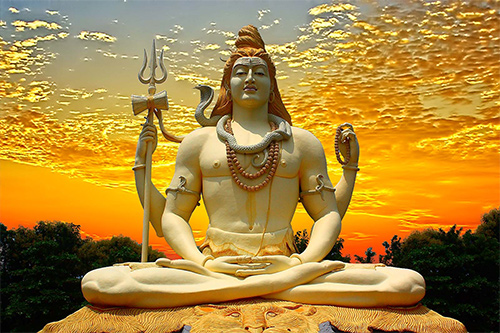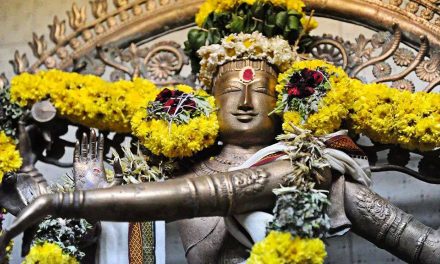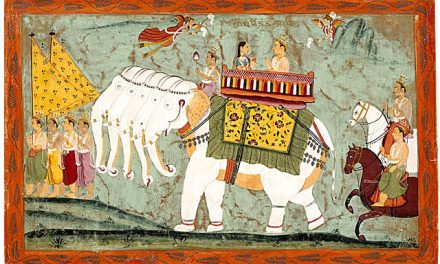
In Hindu philosophy, destruction is considered to be an intense force that shatters delusions and inadequacies bringing forth constructive change through purification. The most powerful member of the triumvirate, Lord Shiva the Destroyer is observed as a complex godhead whose existence fuses conflicting elements. He is believed to be the core of the centrifugal forces of the cosmos due to his role in death and destruction. He dissolves elements in order to create and hence propels the cycle of birth and death. The most formidable deity of the Hindu pantheon is the ultimate seat of ‘Shakti’ and cataclysmic power. With multiple incarnations portraying different shades of Lord Shiva, each has cults which are present across India and South East Asia – in Nepal, Sri Lanka, Malaysia, Singapore and other places.
From the days of Mohenjodaro civilization’s prototype Lord Shiva representations to Vedic literature, Puranic literature and Tantric literature, all of which consist of renditions about Lord Shiva, the Pure One in some form or the other. Known for his feral passion and fearful temperament, Lord Shiva is said to be the greatest ascetic Mahayogi (the Patron God of Yoga and Meditation), passively refraining from all forms of desires and pleasures. At the other end of the spectrum, he exists as hedonist Bhole Nath or Bhole Shankar. Lord Shiva is given the title of the ultimate self-controlled entity abounding in serenity. Contrastingly he is the volatile dancing Nataraja engulfed by wafting flames. Whether Mahadeva or Pashupati, Kala Bhairava or Vishwanath, Mahesh or Bhava – the original rebel is truly the most fascinating Deva. He is the most potent energy in the universe despite being one of ambiguity and paradox. At the highest level he is infinite, transcendental and formless.
The oldest sect of Hinduism Shaivism regards Lord Shiva as all in all – the creator, preserver, destroyer, revealer and concealer of all that is in existence. The Lord of Destruction is generally worshipped in the an iconic form as a Lingam (phallus) but is personified as an ascetic on Mount Kailash or as a domestic partner to Goddess Parvati with two sons Lord Ganesha and Lord Kartikeya and even as a cosmic dancer. His forms are thus both compassionate and terrifying. Shiva’s eternal wife Parvati is an incarnation of his consort Devi, the Mother-goddess. Devi has taken many forms such as Kali, the goddess of death and Sati, the goddess of material felicity and Durga, the invincible goddess, all of whom are linked to the various forms of Shiva.
Lord Shiva the absolute image of masculinity and virility is very distinct in his appearance. He is unlike any other god with his unique get up. His tresses are gloriously piled high on his head with the River Ganges gushing through his matted hair and a resplendent crescent tucked deftly into it. Coiled around his neck is the mighty serpent Kundalini, which is the spiritual energy within life. He wears circular hoop earrings and has a third eye on his forehead. The Transformer’s body is smeared with holy ash or ‘vibhuti’. The ashes embody the final truth that mortals face – the end of all material existence. Lord Shiva also wears his favorite ‘rudraksha’ beads, which is a representation of deep happiness. In his left hand Lord Shiva carries a small leather drum, known as ‘damru’ and on his right he holds a water pot. He sits upright on a gorgeous tiger skin, which denotes the conquering of lust. At other instances, the Lord of Destruction rides his famous ‘vahan’ Nandi, the bull, who is decorated with beautiful garlands.
In the sanctum sanctorum of most temples, the male phallic symbol the Lingam is housed. It is usually placed beneath the spire where it depicts the naval of planet earth. This symbolic image represents both the microcosmic and macrocosmic echelons of the energy that sustains life. It supports life on our planet and also constitutes the life force of the entire universe.
Lord Shiva’s sacred number is five. One of his supreme mantras (the chant na ma si va ya) has five syllables. The Great Benefactor’s body itself is composed of five mantras – called pancabrahmans. These are all forms of divinity with distinct names and iconography. Sadyojata, Vamadeva, Aghora, Tatpurusha and Isana are represented by the five faces of Lord Shiva and are associated with the five elements, the five senses, the five organs of action and the five organs of perception.
Across India, Mahashivaratri is celebrated on the 13th night of the new moon in the Krishna Paksha of the month of Maagha or Phalguna of the Hindu lunar calendar. It marks the night of the original Tandava when Lord Shiva and Goddess Parvati unite in holy matrimony. There are many special prayers and customs. Abhishekams are performed every three hours through the night with offerings like milk, yogurt, honey etc. Bael leaves are also offered ad they are a good sign for a successful life. These are placed much importance to the level of believing that even if those who do not seek blessings place these wreaths, they are endowed with a great life.
Since the Lord of Destruction is related a dark power. Hence to subside negative energy, he consumes opium. His form of Shiva, Bhole Shankar is oblivious to happenings. As per Hindu traditions, on the night of Mahashivratri, devotees especially men, prepare an intoxicating drink called Thandai made milk, almonds and cannabis while offering their prayers. They sing devotional songs and dance to the rhythm of damrus.
In fact dance is an import part of Indian culture. Lord Shiva is the master of the art form and is often referred to as the Lord of Dance. He is most active as a dancer as Nataraja and Dakshinamurthy. The rhythm of dance is an allegory for the delicate balance of the cosmos. His most famous dance is the tandav, the cosmic dance of death. He performs this at the end of every age or yuga.
In Indian spirituality, Lord Shiva commands a high position. He is wise and dynamic, fearless and fierce…the ultimate rebel who has charmed thousands of generations over annals of time.













HELLO !
Is the shiv-ling really a “phallic” symbol ?
The Sanskrit word for the phallus is shishna. I do not understand why so many educated people refer to the lingam as being the shishna.
not exactly. the phallus is a ling-ic organ.
It is purely a misconception to refer to SIVA LINGA AS PHALLIC GOD.
It is purely a misconception to refer to SIVA LINGA AS PHALLIC GOD.
Here LINGA means just A SIGN.
In SUNDARA KANDA (Valmiki Ramayana), SITA DEVI asks HANUMAN the
following question when he says he saw Rama and Lakshmana:
What are their LINGANI ? meaning what are their SIGNS?
So Lingam means only a sign.
,
It may have another meaning referring to male symbol which is not to
be attributed to SIVA LINGAM.
Unfortunately it is the western scholars who are not aware of the
actual import of this meaning of LINGA attributed or called this as
PHALLIC GOD which is purely a misconception on the part of their
wisdom.
So let us not be guided by their interpretation.
This is to say emphatically that SIVA LINGAM is not to be referred to
as PHALLIC GOD. Here LINGAM is just a sign to GOD SIVA.
Thank you.
Dr Subrahmanya Sarma
Shivalinga is a symbolic form of depicting Shiva, who is the Parabramha, the formless one. One who is the source of infinite love, happiness, light and energy.
How does one depict a formless form? The form of one who is “binduswaroopa” ?
The natural and the basic form that of an ovoid comes in handy. hence the formless shiva is depicted in the most basic form of an ovoid in a Shivalinga.
Tantrically speaking Shiva and Shakti are one, in each other and inseperable. They are complimentary to each other and are two functional parts of the same entitiy. Their union is what made this universe happen. The male form of energy depicted by the phallus shape and the female form of energy depicted by the adhaara in the form of a ‘yoni’, thereby denoting the oneness of the female and the male energies in the form of Shiva and Shivalinga.
The Shivalinga symbolizes energy, creation, fertility, continuance, progress, and also reminds us of the formless by being in a basic ovoid form.
To reduce the meaning of shiva linga to a mere sexual act or representation is to attest our own narrowmindedness and lack of knowledge and understanding of the Supreme One who is ever benevolent and full of love for us.
Shivalinga is the symbol of shiv and Shakti together who are the creator of this bhramanda and their divine union resulted in the formation of the universe and all living beings.Importance of family life is being depicted by the shiva pariwar surrounding the shivalinga in every temple you go.He is formless yet he can manifest him self in various forms,shiva being one of them. Shakti is an integral part of shiva.The sacred linga is a symbol of creation itself.Without the linga creation is not possible.
Good explanation
Shiva is Kalyankari.Person who lives to do good of the society in general.
The Shakti is the embodiment force which is always behind Shiva Linga in all temples.The feminine energies for procreation.
Also Ardh-Narishswar is universal form of every human being where he/she is combined union of mother/father genes hence each one is half male/half female combined.
Bhola means innocence & Innocence comes from Purity & Purity is MOTHER of all Values.corruptions kills innocence hence we should be pure.
There is another saying Bhole ka Bhagwan hota Hai.ie Person who is pure is protected by divine.
Shiva is more colourful & powerful than Krishna,also difficult to emulate as he is Neelkantheswar,person who drank poison to protect the world from destruction while he is supposed to be the Destroyer himself.
Shiva also is self-made Yogi who practices all forms of Yoga,he is Bhootnath,ie God of all the Ghosts.
He also guides us to balance between the Vish & Amrit portions of living for balance & cure.